Questions with Answers, Solution | Geometry | Term 1 Chapter 5 | 7th Maths - Exercise 5.6 | 7th Maths : Term 1 Unit 5 : Geometry
Chapter: 7th Maths : Term 1 Unit 5 : Geometry
Exercise 5.6
Exercise
5.6
Miscellaneous
Practice problems
1.
Find the value of x if ∠AOB is a right angle.
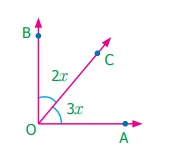
Answer:
∠AOC + ∠COB = 90°
2x + 3x = 90°
5x = 90°
x = 90° / 5 = 18°
x = 18°
2.
In the given figure, find the value of x.
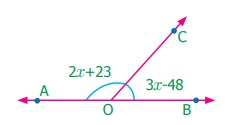
Answer:
∠BOC + ∠AOC = 180°
2x + 23 + 3x – 48 = 180°
5x – 25 = 180°
5x = 180° + 25o
= 205o
x = 205o
/ 5 = 41°
x = 41°
3.
Find the value of x, y and z

Answer:
∠BOD + ∠BOC = 180°
x + 3x + 48 = 180°
4x + 40 = 180°
4x = 180° – 40o
= 140o
x = 140o / 4 = 35°
x = 35°
∠BOD + ∠AOD = 180°
x + y + 30° = 180°
35° + y + 30° = 180°
y = 180° – 65o
y = 115o
∠AOD + ∠AOC = 180°
y + 30° + z + 10° =
180°
115° + z + 40° = 180°
z + 155° = 180°
z = 180° – 155° = 25°
z = 25°
4.
Two angles are in the ratio 11: 25. If they are linear pair, find the angles.
Answer:
Two angles are in the ratio 11:25
Let the two angles be 11x,
25x
Sum of two angles 11x
+ 25x = 180°
36x = 180°
x = 180o
/ 36 = 5°
x = 5°
11x = 11 × 5° = 55°
25x = 25 × 5° = 125°
The two angles are 55o, 125o
5.
Using the figure, answer the following questions and justify your answer.
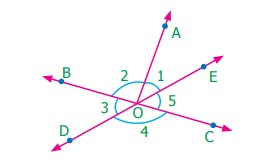
(i)
Is ∠1 adjacent to ∠2?
(ii)
Is ∠AOB adjacent to ∠BOE?
(iii)
Does ∠BOC and ∠BOD form a linear
pair?
(iv)
Are the angles ∠COD and ∠BOD supplementary?
(v) Is ∠3 vertically opposite to ∠1?
(i) Is ∠l adjacent to ∠2?
Yes. They have a common vertex, a common arm and their interiors
do not overlap.
(ii) Is ∠AOB adjacent to ∠BOE?
No. They have overlapping interiors.
(iii) Do ∠BOC and ∠BOD form a linear pair?
No. Since ∠BOC is a straight angle, their sum
will exceed 180°.
(iv) Are ∠COD and ∠BOD supplementary?
Yes. They are linear pair.
(v) Is ∠3 vertically opposite to ∠1 ?
No. They are not formed by intersecting lines.
6.
In the figure POQ, ROS and TOU are straight lines. Find the x°.
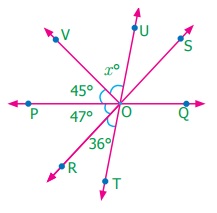
Answer:
∠UOV + ∠VOP + ∠POR + ∠ROT = 180°
x + 45° + 47° + 36° = 180°
x + 128° = 180°
x = 180° – 128° = 52°
x = 52o
7.
In the figure AB is parallel to DC. Find the value of ∠1 and ∠2. Justify
your answer.
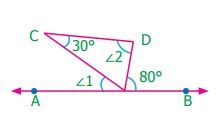
Answer:
From the figure, ∠DCE = ∠1 (alternate angles)
30° = ∠l
∠l = 30°
∠2 = ∠DEB (alternate angles)
∠2 = 80°
8.
In the figure AB is parallel to CD. Find x,y and z.
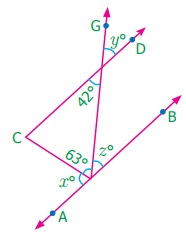
Answer:
From the figure,
∠GED = ∠CEF (vertically opposite angles)
y = 42°
∠CEF = ∠EFB (alternate angles)
42° = ∠z
∠z = 42°
∠AFC + ∠CFE + ∠EFB = 180°
x° + 63°+ z° = 180°
x° + 63° + 42° = 180°
x° + 105° =180°
x° = 180°– 105° = 75°
x° = 75°
x° = 75°, y = 42°, z = 42°
9.
Draw two parallel lines and a transversal. Mark two alternate interior angles G and H. If they are supplementary, what is the measure of each angle?
Answer:
Angles G and H are supplementary
∠G and ∠H are alternate interior angles.
∴ ∠G = ∠H = 90°
10.
A plumber must install pipe 2 parallel to pipe 1. He knows that ∠1 is 53. What is the measure of ∠2?

Answer:
∠1 + ∠2 = 180°
53° + ∠2 = 180°
∠2 = 180° – 53° = 127°
∠2 = 127°
Challenge
Problems
11.
Find the value of y.
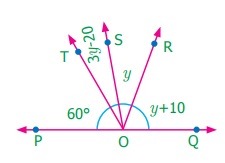
Answer:
∠POT + ∠TOS + ∠SOR + ∠ROQ = 180o
60° + 3y – 20 + y + y + 10 = 180°
60° + 10 – 20 + 5y =
180°
70 – 20 + 5y = 180°
50 + 5y = 180°
5y = 180° – 50° = 130°
y = 130° / 5 = 26o
y = 26°
12.
Find the value of z.
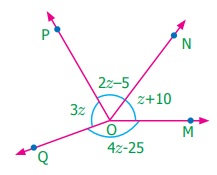
Answer:
∠POQ + ∠QOM + ∠MON + ∠PON = 360o
3z + 4z –25 + z + 10 +2z – 5 = 360o
3z + 4z + z + 2z
+ 10 – 25 – 5 = 360o
10z – 20 = 360o
10z = 360o + 20o = 380o
z = 380o /
10 = 38o
z = 38o
13.
Find the value of x and y if
RS is parallel to PQ.
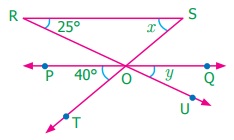
Answer:
From the figure,
∠POR = ∠ORS (alternate angles)
∠POR = 25°
∠POR = ∠QOU (vertically opposite angles)
∠QOU = 25°
y = 25°
∠POT = ∠SOQ (vertically opposite angles)
40° = ∠SOQ
∠RSO = ∠SOQ (alternate angles)
x° = 40°
y° = 25°
14. Two parallel lines are cut by a transversal. For each pair of interior angles on the same side of the transversal, if one angle exceeds the twice of the other angle by 48°. Find the angles.
Answer:
Given one angle exceeds twice of other angle by 48°
= 2x + 48
Other angle = x°
Sum of interior angles = x°
+ 2x° + 48° = 180°
3x + 48° = 180°
3x = 180° – 48° = 132°
x = 132o / 3 = 44o
x = 44°
2x + 48 = 2 × 44 + 48
= 88 + 48° = 136°
The angles are 44°, 136°.
15.
In the figure, the lines GH and IJ are parallel. If ∠1=108° and ∠2 = 123°, find
the value of x, y and z.
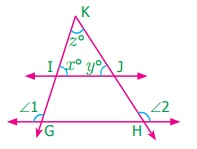
Answer:
∠1 = 108°
Interior angle ∠G = 180o – 108o = 72o
x° = Interior angle ∠G (corresponding angles)
x° = 72°
∠2 = 123°
Interior angle
∠H = 180° – 123° = 57°
y° = Interior angle ∠H = (corresponding angles)
y = 57°
x° + y° + 2° = 180°
(sum of the triangles)
72° + 57° + z° = 180°
129° + z° = 180°
z° = 180° – 129° = 51°
x° = 72°, y° = 57°, z = 51°
16.
In the parking lot shown, the lines that mark the width of each space are parallel.
If ∠1 = (2x–3y)°, ∠2 = (x +39)°, find x and y.
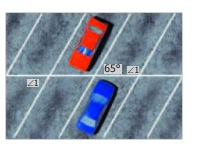
Answer:
∠2 + 65° = 180° (interior angles)
(x + 39) + 65° = 180°
x + 104° = 180°
x = 180° – 104° = 76°
x = 76°
∠1= 65° (vertically opposite angles)
(2x – 3y)o = 65°
2(76o) – 3yo
= 65°
152o – 3yo
= 65o
–3y° = 65° – 152° = –87o
y = –87 / –3 = 29°
y = 29°
x = 76° , y = 29°
17. Draw two parallel lines and a transversal. Mark two corresponding angles A and B. If ∠A = 4x and ∠B = 3x + 7, find the value of x. Explain..
Answer:
A and B are corresponding angles.
∠A = ∠B
4x = 3x + 7
4x – 3x = 7
x = 7°
18. In the figure AB is parallel to
CD. Find x˚, y˚ and z˚.
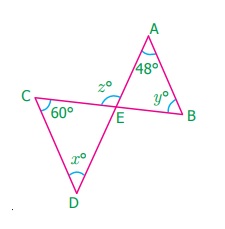
Answer:
∠A = ∠D (alternate angles)
x° = 48°
∠C = ∠B (alternate angles)
y° = 60°
from ΔCDE,
∠C + ∠D + ∠E = 180° (sum of the three
angles of a triangle)
60° + 48° + ∠E = 180°
108° + ∠E = 180°
∠E = 180° – 108°
∠E = 72°
∠E + Z° = 180°∠ (straight angles)
72° + Z° = 180°
Z° = 180° – 72° = 108°
Z° =108°
x = 48° y = 60°
z = 108°
19. Two parallel lines are cut by a transversal. If one angle of a pair of corresponding angles can be represented by 42˚ less than three times the other. Find the corresponding angles.
Answer:
One angle = x
Other angle = 42 less than 3 times the other
= 3x – 42
The corresponding angles are equal
3x – 42 = x
3x – x = 42
2x = 42
x = 21
The corresponding
angles = 21
20.
In the given figure, ∠8 = 107˚, what
is the sum of the ∠2 and ∠4?
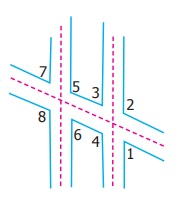
Answer:
∠8 = ∠4 (Corresponding angles)
∠8 = 107°
∴ ∠4 = 107°
∠4 = ∠2 (vertically opposite angles)
∠2 = 107°
The sum of ∠2 and ∠4 = 107° + 107° = 214°.
ANSWERS
Exercise 5.6
1. 18°
2. 41°
3. 35°, 115°, 25°
4. 55°, 125°
5. (i) Yes. They have a common
vertex, a common arm and their interiors do not overlap.
(ii) No. They have overlapping
interiors.
(iii) No. Since ∠BOC is a straight angle, their
sum will exceed 180°.
(iv) Yes. They are linear pair.
(v) No. They are not formed by
intersecting lines
6. 52°
7. 30°, 80°
8. 75° , 42° , 42°
9. 90°
10. 127°
Challenge Problems
11. 26°
12. 38°
13. 40°,25°
14. 44°
15. 72°,57°,51°
16. 76°,29°
17. 7°
18. 48°,60°,108°
19. 21°
20. 214°
Related Topics